Frequency Switchable Global RFID Tag Antennae with Metal Compatibility for Worldwide Vehicle Transportation
Abstract
:1. Introduction
2. Antenna Geometry
PIN Diode as Switch in the Proposed Antenna Design
3. Results and Discussion
3.1. Parametric Study
3.2. Electric Field Vector Analysis of the Re-Configurable Antenna
3.3. Equivalent Circuit Analysis
4. Fabrication and Measurement
5. Conclusions
Author Contributions
Funding
Institutional Review Board Statement
Informed Consent Statement
Data Availability Statement
Acknowledgments
Conflicts of Interest
References
- Finkelzeller, K. The RFID Handbook, 3rd ed.; John Wiley & Sons: West Sussex, UK, 2010; pp. 24–26. [Google Scholar]
- Jouali, R.; Aoutoul, M.; Ouahmane, H.; Ahmad, S.; Had, A.; El Moukhtafi, F.; Parchin, N.O.; See, C.H.; Abd-Alhameed, R. Design of an Analog RFID-Based Tag Antenna with Opened Circuited L-Shaped Stubs for Applications in Localization. Electronics 2022, 11, 1027. [Google Scholar] [CrossRef]
- Ez-zaki, F.; Belaid, K.A.; Ahmad, S.; Belahrach, H.; Ghammaz, A.; Al-Gburi, A.J.A.; Parchin, N.O. Circuit Modelling of Broadband Antenna Using Vector Fitting and Foster Form Approaches for IoT Applications. Electronics 2022, 11, 3724. [Google Scholar] [CrossRef]
- El Moukhtafi, F.; Aoutoul, M.; Sabri, K.; Sarosh, A.; Khoukh, A.; Errami, Y.; Jouali, R.; Haddad, A.; Had, A. A Planar Patch Antenna Array Design with Reduced Mutual Coupling Using a Novel Absorber. Arab. J. Sci. Eng. 2022, 47, 8. [Google Scholar] [CrossRef]
- Faouri, Y.; Ahmad, S.; Naseer, S.; Alhammami, K.; Awad, N.; Ghaffar, A.; Hussein, M.I. Compact Super Wideband Frequency Diversity Hexagonal Shaped Monopole Antenna with Switchable Rejection Band. IEEE Access 2022, 10, 42321–42333. [Google Scholar] [CrossRef]
- Barman, B.; Bhaskar, S.; Singh, A.K. Spiral resonator loaded S-shaped folded dipole dual band UHF RFID tag antenna. Microw. Opt. Technol. Lett. 2018, 61, 720–726. [Google Scholar] [CrossRef]
- Panda, J.R.; Kshetrimayum, R.S. An F-shaped printed monopole antenna for dual-band RFID and WLAN applications. Microw. Opt. Technol. Lett. 2011, 53, 1478–1481. [Google Scholar] [CrossRef]
- Mun, B.; Yoon, Y.; Lee, H.; Lee, H.-Y.; Lee, B. A Compact Dual-Band RFID Tag Antenna Mountable on Metallic Objects. Int. J. Antennas Propag. 2015, 2015, 1–8. [Google Scholar] [CrossRef] [Green Version]
- Barman, B.; Bhaskar, S.; Singh, A.K. Dual-band UHF RFID tag antenna using two eccentric circular rings. Prog. Electromagn. Res. M 2017, 71, 127–136. [Google Scholar] [CrossRef] [Green Version]
- Bhaskar, S.; Singh, A.K. A dual band dual antenna with read range enhancement for UHF RFID tags. Int. J. RF Microw. Comput. Eng. 2019, 29, e21717. [Google Scholar] [CrossRef]
- You, F.; Jiang, Z. A broadband UHF RFID tag antenna design for metallic surface using module matching. Prog. Electromagn. Res. Lett. 2021, 95, 83–90. [Google Scholar] [CrossRef]
- Ripin, N.; Lim, E.-H.; Bong, F.-L.; Chung, B.-K. Miniature Folded Dipolar Patch with Embedded AMC for Metal Mountable Tag Design. IEEE Trans. Antennas Propag. 2020, 68, 3525–3533. [Google Scholar] [CrossRef]
- Hazarika, B.; Basu, B.; Nandi, A. Design of antennas using artificial magnetic conductor layer to improve gain, flexibility, and specific absorption rate. Microw. Opt. Technol. Lett. 2020, 62, 3928–3935. [Google Scholar] [CrossRef]
- Nguyen, M.; Lin, Y.; Chang, C.; Chen, C.; Chen, H. Compact shorted C-shaped patch antenna for ultrahigh frequency radio frequency identification tags mounted on a metallic plate. Int. J. RF Microw. Comput. Eng. 2021, 31, e22595. [Google Scholar] [CrossRef]
- Ng, W.-H.; Lim, E.-H.; Bong, F.-L.; Chung, B.-K. E-Shaped Folded-Patch Antenna With Multiple Tuning Parameters for On-Metal UHF RFID Tag. IEEE Trans. Antennas Propag. 2018, 67, 56–64. [Google Scholar] [CrossRef]
- Niew, Y.H.; Lee, K.Y.; Lim, E.H.; Bong, F.L.; Chung, B.K. Miniature Dipolar Patch Antenna with Non-resonating Ring for Metal-Insensitive UHF RFID Tag Design. IEEE Trans. Antennas Propag. 2019, 68, 2393–2398. [Google Scholar] [CrossRef]
- Niew, Y.-H.; Lee, K.-Y.; Lim, E.-H.; Bong, F.-L.; Chung, B.-K. Patch-Loaded Semicircular Dipolar Antenna for Metal-Mountable UHF RFID Tag Design. IEEE Trans. Antennas Propag. 2019, 67, 4330–4338. [Google Scholar] [CrossRef]
- Lee, S.-R.; Lim, E.-H.; Bong, F.-L.; Chung, B.-K. High-Efficient Compact Folded-Patch Antenna Fed by T-Shaped L-Probe for On-Metal UHF RFID Tag Design. IEEE Trans. Antennas Propag. 2019, 68, 152–160. [Google Scholar] [CrossRef]
- Nguyen, M.-T.; Lin, Y.-F.; Chen, C.-H.; Chang, C.-H.; Chen, H.-M. Shorted Patch Antenna with Multi Slots for a UHF RFID Tag Attached to a Metallic Object. IEEE Access 2021, 9, 111277–111292. [Google Scholar] [CrossRef]
- Byondi, F.K.; Chung, Y. Longest-Range UHF RFID Sensor Tag Antenna for IoT Applied for Metal and Non-Metal Objects. Sensors 2019, 19, 5460. [Google Scholar] [CrossRef] [Green Version]
- Jin, G.; Li, M.; Wang, W.; Li, L.; Liao, S. A Planar Beam-Switching Dipole Antenna. IET Microw. Antennas Propag. 2019, 13, 997–1002. [Google Scholar] [CrossRef]
- Nazir, I.; Rana, I.E.; Mir, N.U.A.; Afreen, K. Design and analysis of a frequency reconfigurable microstrip patch antenna switching between four frequency bands. Prog. Electromagn. Res. C 2016, 68, 179–191. [Google Scholar] [CrossRef] [Green Version]
- Available online: https://www.infineon.com/dgdl/Infineon-BAR64-02V-DS-v01_01 (accessed on 1 November 2022).
- Available online: https://www.nxp.com/docs/en/data-sheet/SL3S1203_1213.pdf (accessed on 1 November 2022).
- Balanis, C.A. Antenna Theory: Analysis and Design, Hoboken; John Wiley & Sons, Inc.: Hoboken, NJ, USA, 2005. [Google Scholar]
- Zhang, J.; Long, Y. A Novel Metal-Mountable Electrically Small Antenna for RFID Tag Applications with Practical Guidelines for the Antenna Design. IEEE Trans. Antennas Propag. 2014, 62, 5820–5829. [Google Scholar] [CrossRef]
- Booket, R.; Kamyab, M.; Jafargholi, A.; Seyed Mostafa, M. Analytical modeling of the printed dipole antenna loaded with CRLH structures. Prog. Electromagn. Res. B 2010, 20, 167–186. [Google Scholar] [CrossRef] [Green Version]
- Olaode, O.O.; Palmer, W.D.; Joines, W.T. Effects of Meandering on Dipole Antenna Resonant Frequency. IEEE Antennas Wirel. Propag. Lett. 2012, 11, 122–125. [Google Scholar] [CrossRef]
- Lee, H.; Lim, H.; Bong, L.; Chung, B. Loop-fed Planar Inverted-L Antennas (PILAs) for Omnidirectional UHF On-Metal Tag Design. IEEE Trans. Antennas Propag. 2020, 68, 5864–5871. [Google Scholar] [CrossRef]
- Lee, S.R.; Ng, W.H.; Lim, E.H.; Bong, F.L.; Chung, B.K. Compact Magnetic Loop Antenna for Omnidirectional On-Metal UHF Tag Design. IEEE Trans. Antennas Propag. 2020, 68, 765–772. [Google Scholar] [CrossRef]
- Lee, R.; Lim, H.; Bong, L.; Chung, B. Slotted Folded Patch Antenna with Double-T-slots for Platform Insensitive UHF Tag Design. IEEE Trans. Antennas Propag. 2018, 67, 670–675. [Google Scholar] [CrossRef]
- Erman, F.; Mansour, D.; Kouali, M.; Shabaneh, A.; Leifsson, L.; Koziel, S.; Lim, E.-H.; Hanafi, E. Low-Profile Interdigitated UHF RFID Tag Antenna for Metallic Objects. IEEE Access 2022, 10, 90915–90923. [Google Scholar] [CrossRef]
- Ng, W.-H.; Lim, E.-H.; Bong, F.-L.; Chung, B.-K. Folded Patch Antenna with Tunable Inductive Slots and Stubs for UHF Tag Design. IEEE Trans. Antennas Propag. 2018, 66, 2799–2806. [Google Scholar] [CrossRef]


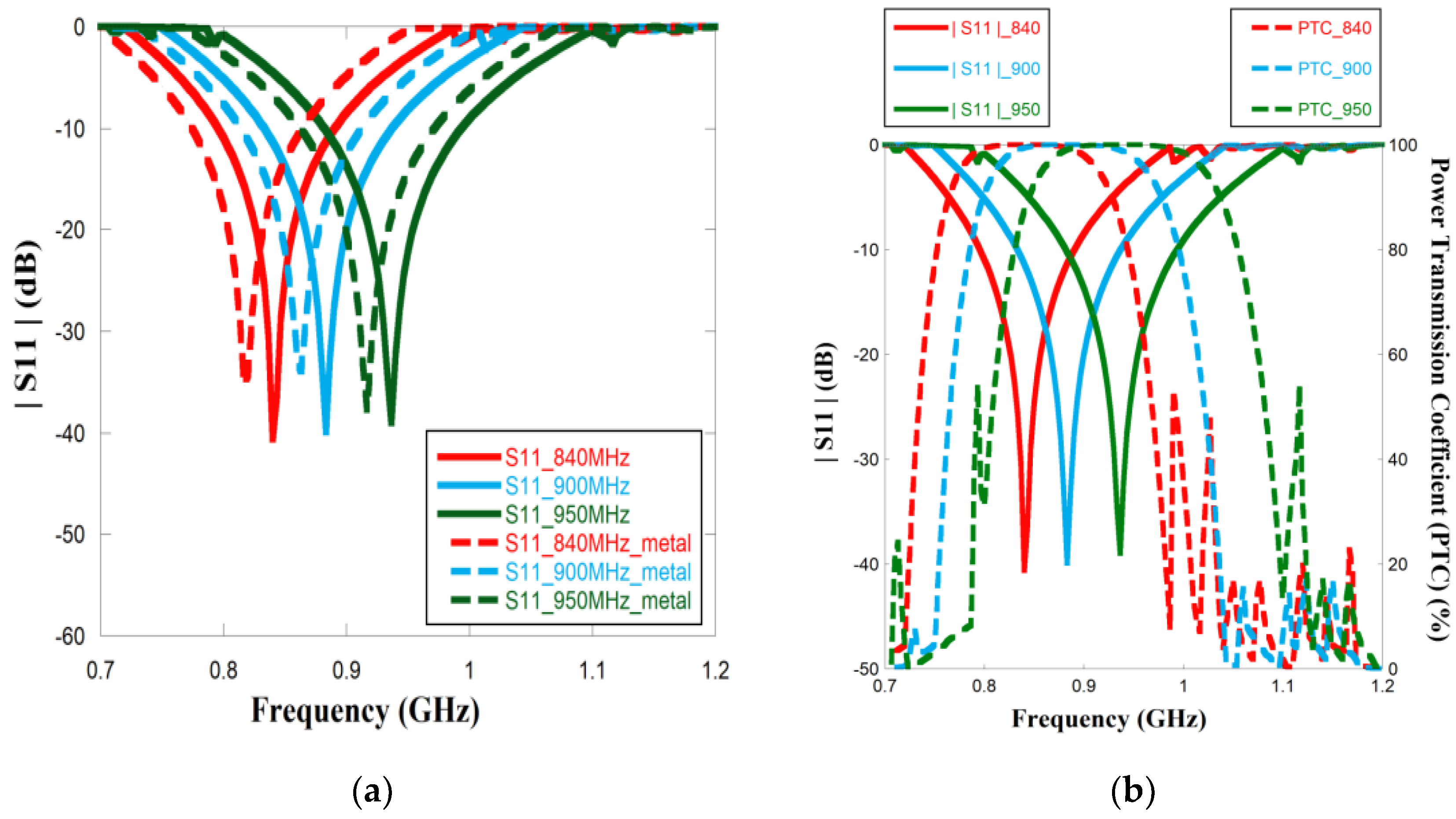
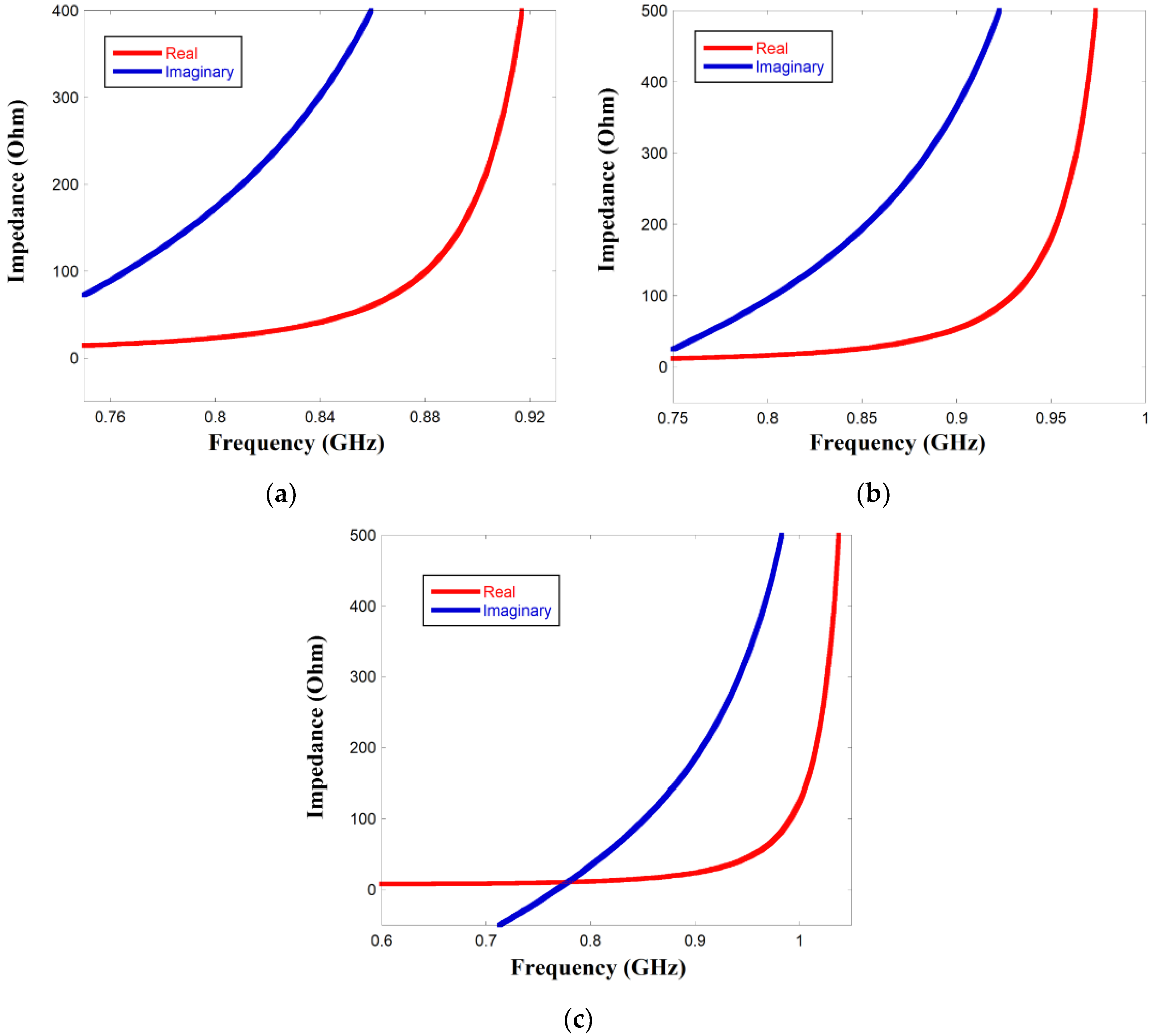
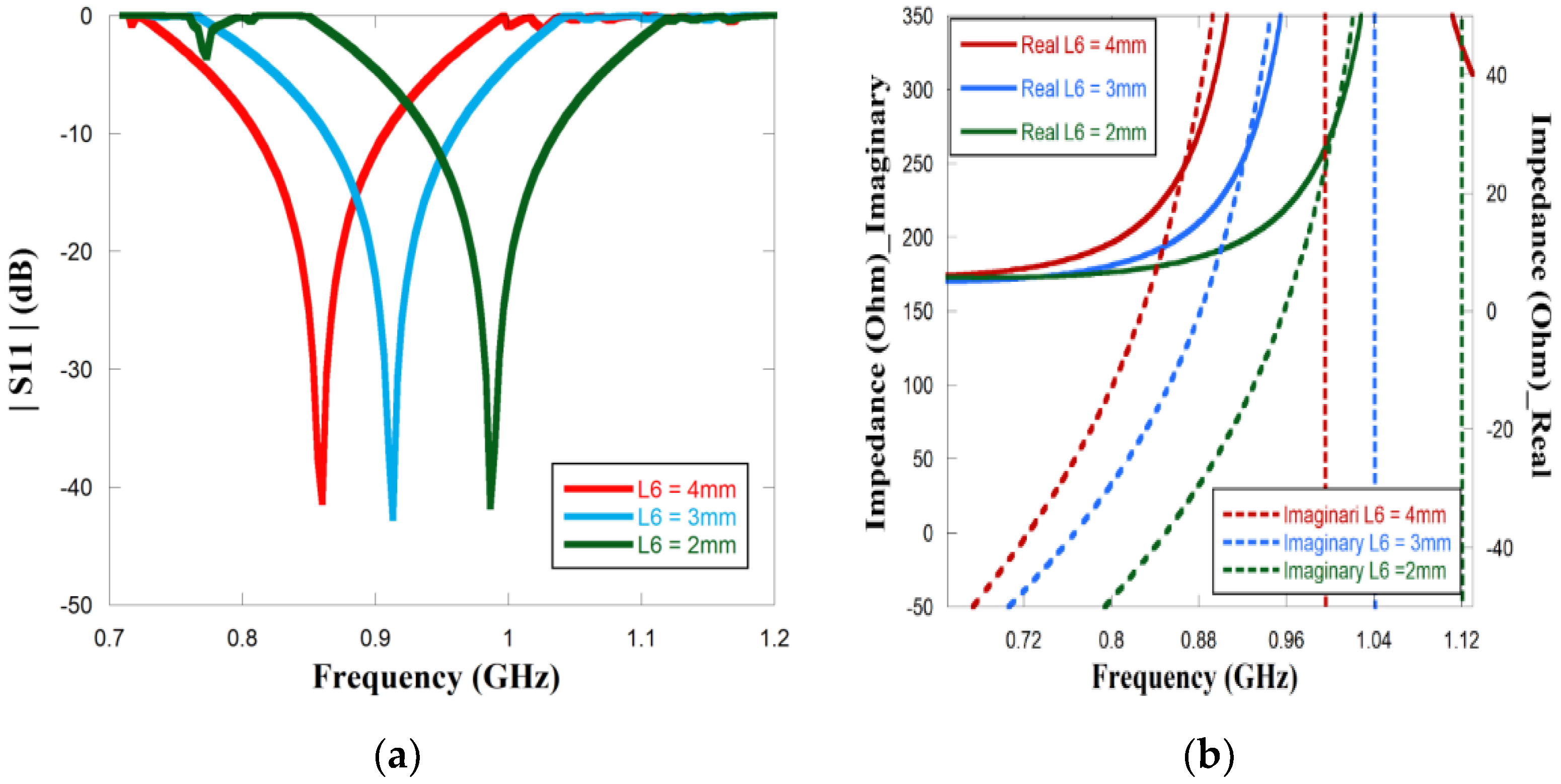
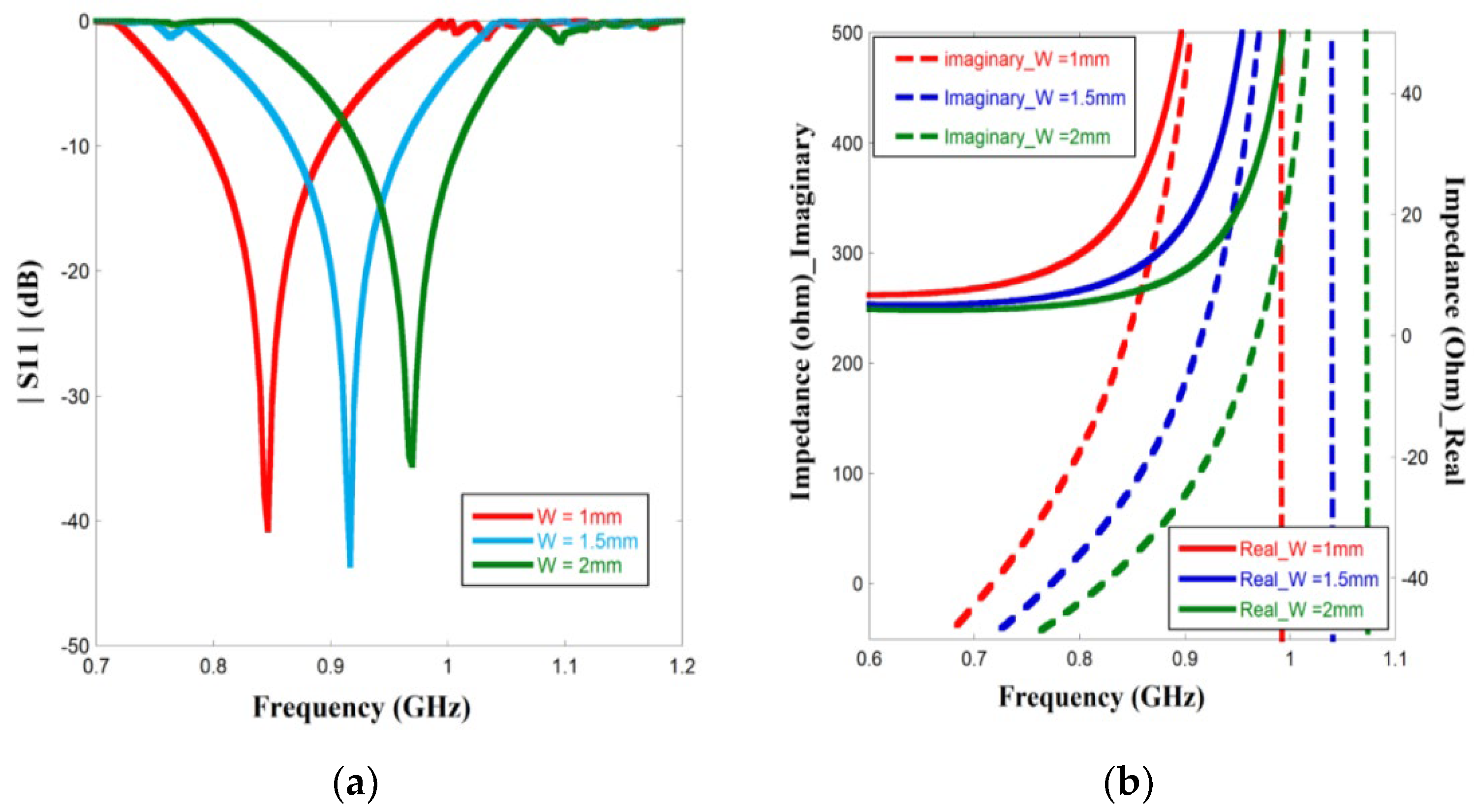
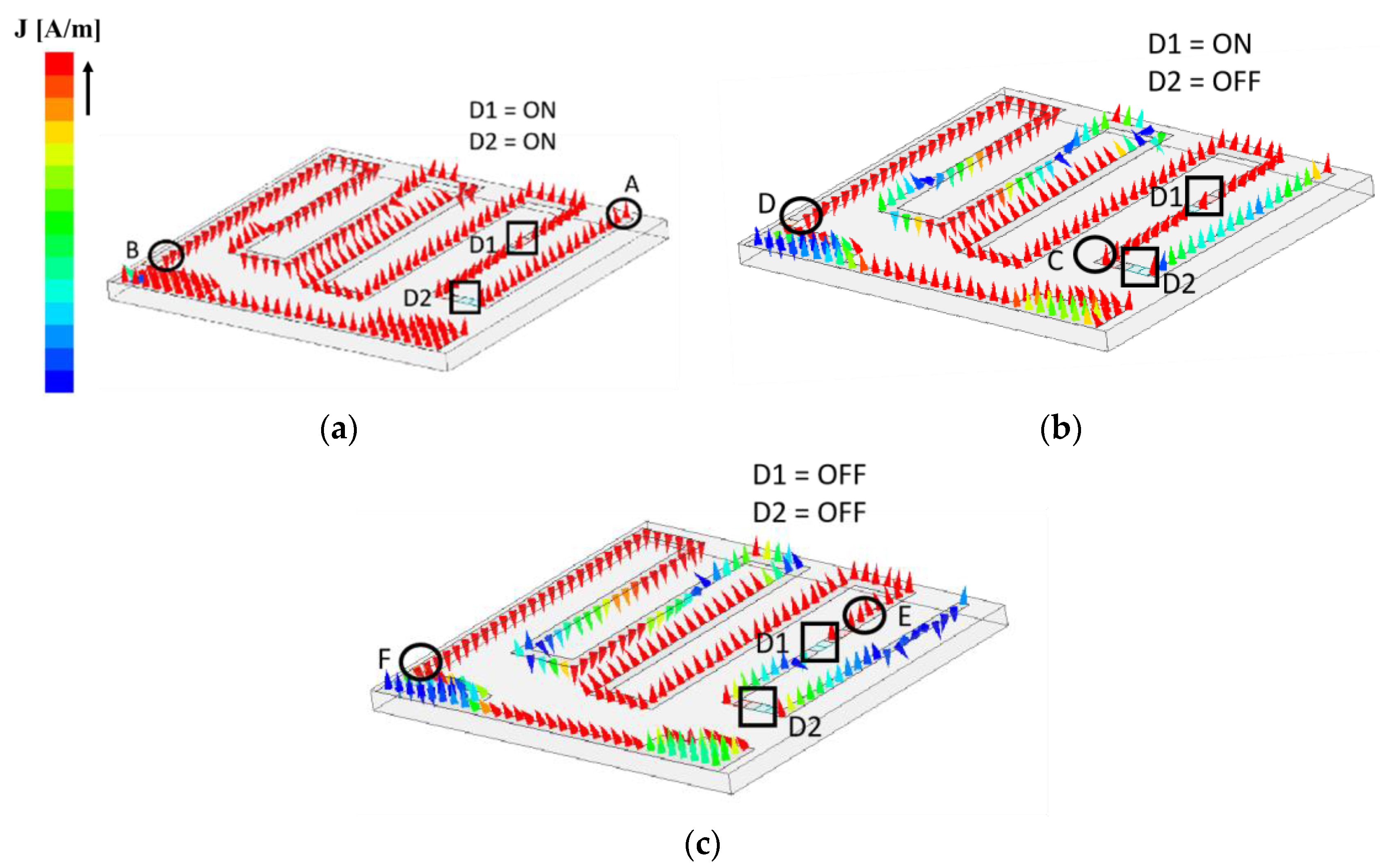
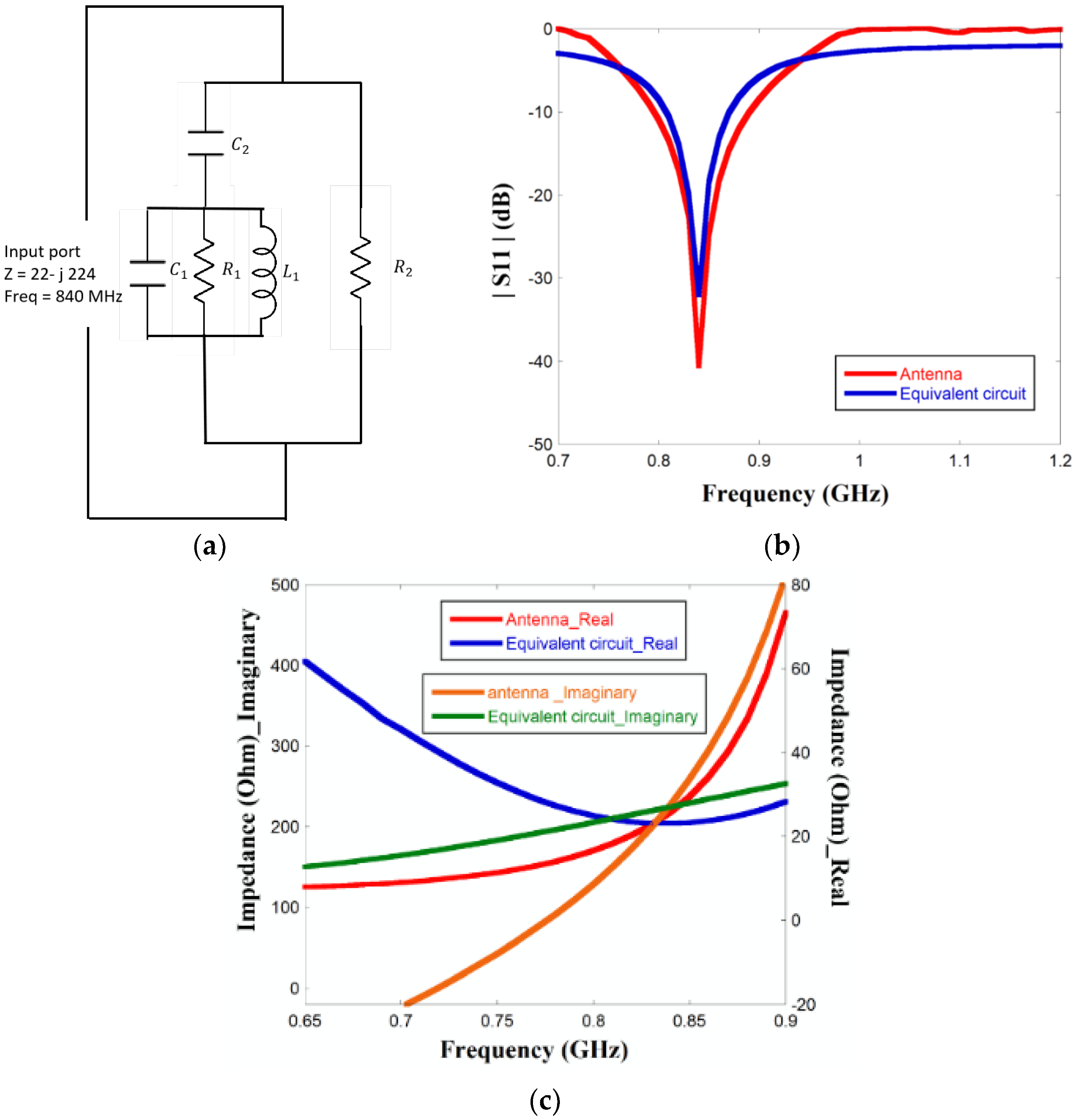


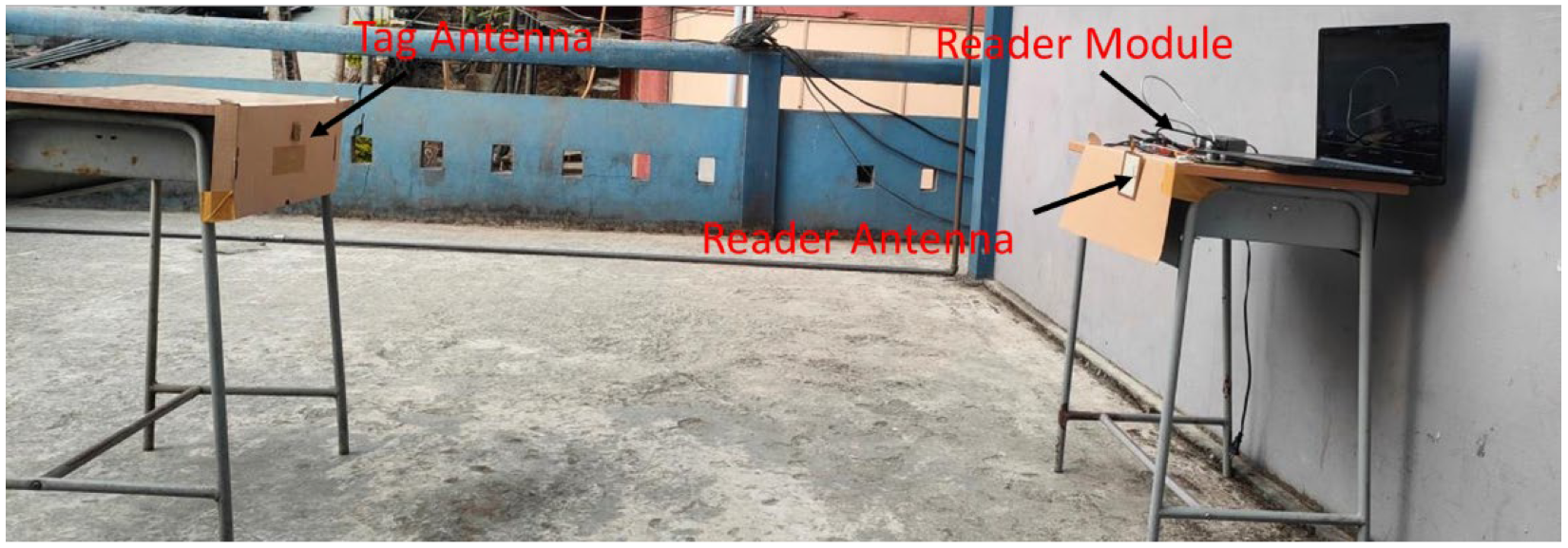

| Parameter | Dimensions (mm) | ||||||
|---|---|---|---|---|---|---|---|
| Substrate | LS | WS | |||||
| 30 | 34 | ||||||
| Radiating element | L1 | L2 | L3 | L4 | L5 | L6 | W |
| 24 | 20 | 23 | 4 | 13 | 4 | 1 | |
| Ground | LG | LG1 | LG2 | ||||
| 32.5 | 22 | 16 | |||||
| Diode Condition | Resonant Frequency (GHz) | Impedance Bandwidth (%) | |||
|---|---|---|---|---|---|
| D1 | D2 | Antenna without Metal Plate | Antenna with Metal Plate | Antenna without Metal Plate | Antenna with Metal Plate |
| ON | ON | 0.835 | 0.82 | 11 | 10.9 |
| ON | OFF | 0.88 | 0.86 | 11.8 | 12.7 |
| OFF | OFF | 0.93 | 0.92 | 11.9 | 10.8 |
| Average Impedance of Microchip is 22 − j224 Ω | Frequency (MHz) | Impedance (Ω) |
| 835 | 28 + j218 | |
| 880 | 24 + j219 | |
| 930 | 28 + j223 |
| Ref | Tag Size | Resonant Frequency (MHz) | Input Impedance (Ohm) | Power (W) | Chip Sensitivity (dBm) | Realized Gain (dB) | Max Read Range (m) |
|---|---|---|---|---|---|---|---|
| [16] | 0.26 × 0.26 | 917 | 6.17 − j162.97 | 4 | −17.8 | −5.78 | 6.5 |
| [29] | 0.12 × 0.122 | 915 | 12.1 − j161.51 | 4 | −20 | −5.08 | 7 |
| [30] | 0.116 × 0.116 | 915 | 14.6 − j161.25 | 4 | −17.8 | −6.84 | 5.65 |
| [31] | 0.12 × 0.152 | 912 | 11.9 − j118.94 | 4 | −20 | −8 | 5.2 |
| [32] | 0.12 × 0.152 | 915 | 20.9 − j193.16 | 4 | −20.5 | −4.11 | 8.14 |
| [33] | 0.156 × 0.156 | 867 | 13.4 − j126.1 | 3.28 | −20 | −8 | 5.52 |
| This work | 0.083 × 0.094 | 836 889 930 | 22 − j224 | 4 | −18 | −8.4 −9.2 −9.5 | 6.04 6.42 4.21 |
Disclaimer/Publisher’s Note: The statements, opinions and data contained in all publications are solely those of the individual author(s) and contributor(s) and not of MDPI and/or the editor(s). MDPI and/or the editor(s) disclaim responsibility for any injury to people or property resulting from any ideas, methods, instructions or products referred to in the content. |
© 2023 by the authors. Licensee MDPI, Basel, Switzerland. This article is an open access article distributed under the terms and conditions of the Creative Commons Attribution (CC BY) license (https://creativecommons.org/licenses/by/4.0/).
Share and Cite
Mazumder, K.; Ghosh, A.; Bhattacharya, A.; Ahmad, S.; Ghaffar, A.; Hussein, M. Frequency Switchable Global RFID Tag Antennae with Metal Compatibility for Worldwide Vehicle Transportation. Sensors 2023, 23, 3854. https://doi.org/10.3390/s23083854
Mazumder K, Ghosh A, Bhattacharya A, Ahmad S, Ghaffar A, Hussein M. Frequency Switchable Global RFID Tag Antennae with Metal Compatibility for Worldwide Vehicle Transportation. Sensors. 2023; 23(8):3854. https://doi.org/10.3390/s23083854
Chicago/Turabian StyleMazumder, Krishna, Anumoy Ghosh, Anagha Bhattacharya, Sarosh Ahmad, Adnan Ghaffar, and Mousa Hussein. 2023. "Frequency Switchable Global RFID Tag Antennae with Metal Compatibility for Worldwide Vehicle Transportation" Sensors 23, no. 8: 3854. https://doi.org/10.3390/s23083854








